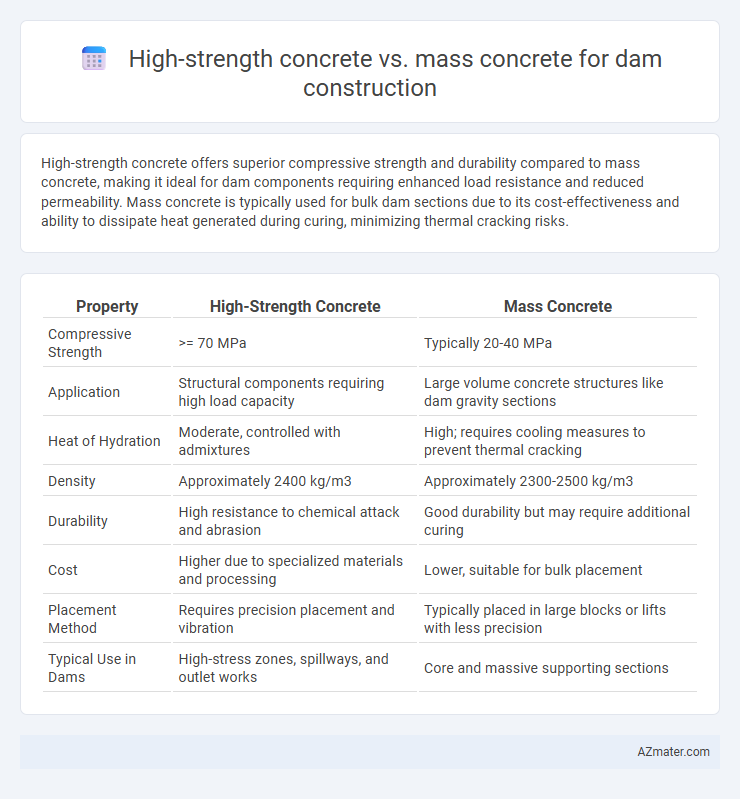High-strength concrete offers superior compressive strength and durability compared to mass concrete, making it ideal for dam components requiring enhanced load resistance and reduced permeability. Mass concrete is typically used for bulk dam sections due to its cost-effectiveness and ability to dissipate heat generated during curing, minimizing thermal cracking risks.
Table of Comparison
| Property | High-Strength Concrete | Mass Concrete |
|---|---|---|
| Compressive Strength | >= 70 MPa | Typically 20-40 MPa |
| Application | Structural components requiring high load capacity | Large volume concrete structures like dam gravity sections |
| Heat of Hydration | Moderate, controlled with admixtures | High; requires cooling measures to prevent thermal cracking |
| Density | Approximately 2400 kg/m3 | Approximately 2300-2500 kg/m3 |
| Durability | High resistance to chemical attack and abrasion | Good durability but may require additional curing |
| Cost | Higher due to specialized materials and processing | Lower, suitable for bulk placement |
| Placement Method | Requires precision placement and vibration | Typically placed in large blocks or lifts with less precision |
| Typical Use in Dams | High-stress zones, spillways, and outlet works | Core and massive supporting sections |
Introduction to Dam Construction Materials
High-strength concrete offers superior compressive strength and durability, making it ideal for critical dam components requiring enhanced load-bearing capacity. Mass concrete, characterized by its large volume and low heat of hydration, is essential for constructing massive dam sections to prevent thermal cracking. Selecting appropriate concrete types based on structural and thermal requirements ensures the dam's long-term stability and performance.
Understanding High-Strength Concrete
High-strength concrete, typically defined by compressive strengths exceeding 6,000 psi (41 MPa), offers superior durability and reduced permeability, making it ideal for structural components in dam construction that require enhanced load-bearing capacity. Unlike mass concrete, which is characterized by its large volume and lower strength to mitigate thermal cracking, high-strength concrete enables thinner sections and greater design flexibility due to its improved mechanical properties and lower water-cement ratio. Understanding the material's behavior under high compressive strains and its influence on thermal properties is crucial for optimizing dam safety and longevity.
Overview of Mass Concrete
Mass concrete in dam construction involves large volumes of concrete placed in one continuous operation, designed to withstand enormous structural loads and thermal stresses. It requires careful management of heat generation from cement hydration to prevent cracking, often utilizing low-heat cement and controlled curing methods. The density, durability, and thermal stability of mass concrete make it essential for the stability and longevity of gravity and arch dams.
Key Material Properties Compared
High-strength concrete for dam construction exhibits higher compressive strength, typically exceeding 60 MPa, which enhances structural durability and reduces material volume. Mass concrete, characterized by lower strength ranging from 20 to 40 MPa, is designed to manage heat of hydration and minimize thermal cracking during curing. Key material properties compared include thermal conductivity, heat of hydration, modulus of elasticity, and permeability, with mass concrete optimized for thermal control and high-strength concrete optimized for load-bearing capacity.
Structural Performance in Dams
High-strength concrete provides superior compressive strength and durability, enhancing the structural performance of dams by reducing crack formation and increasing resistance to hydrostatic pressure. Mass concrete, characterized by its large volume and lower strength, offers better thermal stability and minimizes the risk of thermal cracking during curing, which is critical for the dam's long-term integrity. Selecting between high-strength and mass concrete depends on the specific structural demands and thermal management requirements of the dam project.
Thermal Considerations and Cracking
High-strength concrete used in dam construction offers superior compressive strength but generates increased heat of hydration, elevating thermal gradients that risk cracking during curing. Mass concrete, designed with lower cement content and slower hydration rates, minimizes temperature rise and thermal stresses, reducing the likelihood of thermal cracking in large-volume placements. Effective thermal management through cooling pipes or staged pours is crucial to mitigate cracking in both high-strength and mass concrete applications for dam structures.
Construction Techniques and Methods
High-strength concrete offers superior compressive strength and durability, enabling thinner dam sections and faster construction with less material usage compared to mass concrete. Construction techniques for high-strength concrete involve precise mix design, controlled curing, and the use of advanced admixtures to achieve optimal performance under high stress conditions. Mass concrete construction methods prioritize heat management and thermal control through staged placement, cooling pipes, and low-heat cement to prevent cracking and ensure structural integrity over large volumes.
Durability and Long-Term Maintenance
High-strength concrete offers enhanced durability in dam construction by providing superior resistance to chemical attacks, freeze-thaw cycles, and abrasion, which reduces long-term maintenance needs. Mass concrete, characterized by its lower strength but higher volume, requires careful thermal control during curing to prevent cracking and maintain structural integrity over time. Effective long-term maintenance depends on selecting the appropriate concrete type based on site-specific environmental conditions and the dam's load requirements.
Cost Implications for Dam Projects
High-strength concrete offers reduced material volume and enhanced durability, leading to lower long-term maintenance expenses in dam construction, while its initial costs remain higher due to specialized mix designs and quality control. Mass concrete, typically cheaper upfront due to simpler mix formulations and local material use, may incur elevated costs over time from thermal cracking mitigation and extensive curing processes. Decision-making balances the immediate budget constraints with lifecycle cost savings, often favoring high-strength concrete for large-scale dams with rigorous performance requirements.
Choosing the Right Concrete for Your Dam
High-strength concrete offers superior compressive strength and durability, making it ideal for dam sections subjected to intense mechanical stress and seismic forces. Mass concrete, characterized by its large volume and low heat of hydration, effectively minimizes thermal cracking in massive dam structures during curing. Selecting the appropriate concrete depends on load requirements, thermal control needs, and environmental conditions to ensure structural integrity and longevity.

Infographic: High-strength concrete vs Mass concrete for Dam construction
 azmater.com
azmater.com